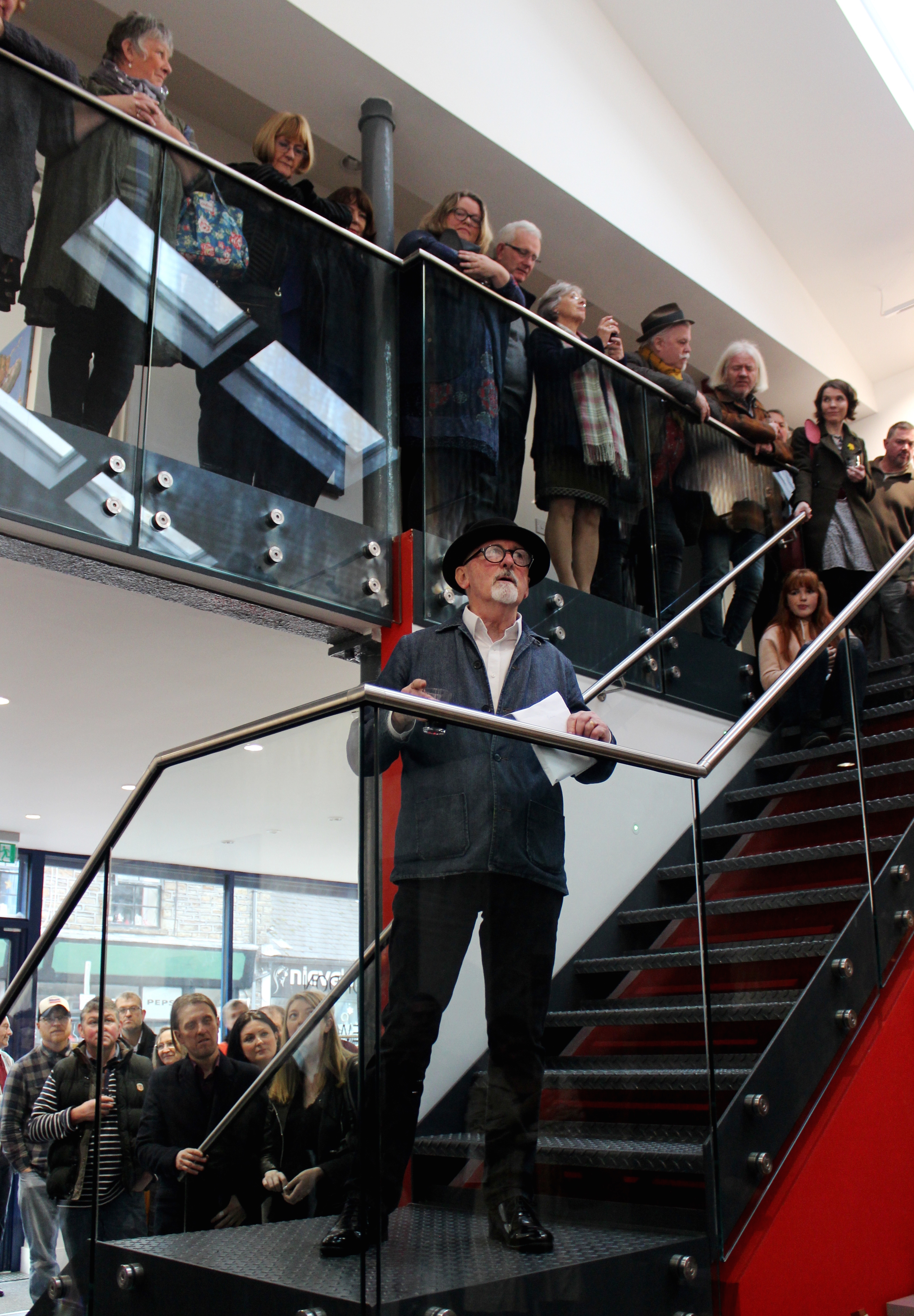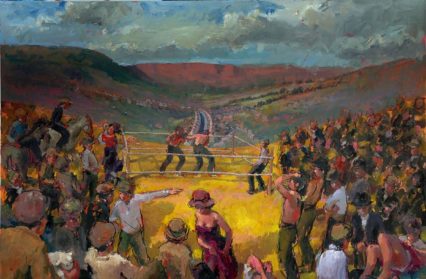Jo Mazelis talks to Kevin Sinnott about ‘The History Paintings’ a series of paintings he is showing in Pontycymmer.
Something strange is happening in Pontycymmer, a double-fronted shop that was semi-derelict for years has been, almost miraculously it seems, transformed into a large and elegant gallery. This has been the work of one man, the painter Kevin Sinnott, who has lived and worked in the valley for the last twenty years.
Sinnott is best known for paintings which set vivid and physically active figures against landscapes of terraced houses, Chinese takeaways, satellite dishes, metal fire escapes and distant mountains. Men, women, children and dogs frolic and fight, cavort and cwtch; they climb mountains; they loll on grassy pastures or on sun beds in concrete-paved backyards.

I went to visit Kevin Sinnott the week before the official opening of the gallery while he was busy with last minute details and press releases. I asked him why he had created the sort of ‘white cube’ gallery you’d expect to find in London or Cardiff in Pontycymmer. ‘I think that artists are always looking around at abandoned buildings with the idea of potential studio space and there is way that a gallery is not a million miles from a studio.’ I pointed out that a studio, by its very nature is a workspace and thus somewhat messier than the pure white painted space of a gallery. Sinnott said, ‘Perhaps it is bizarre, but my inspiration comes from Pontycymmer, so it seemed right to do it here. It’s convenient too, as I live nearby.’
Pontycymmer is a small town that nestles in the narrow Garw Valley. Once the site of several coal mines, the Glengarw, the Lluest, the Garw, the Ffaldau, the International and the Darren, it now seems quiet and the main shopping street is not the bustling commercial centre it once was. History has changed the South Wales coalmining valleys, transforming the once peaceful rural landscape into an industrial one with the stark outlines of winding towers, slag heaps and pithead baths, then with the closures of the pits in the 1980s, reverting back to nature once more. It is easy to forget what these places once were; what the character of the Welsh in these places was; how the sense of community and solidarity bound people together at work and at play. The main series of paintings Sinnott is showing at his inaugural exhibition at Studio 18 are all re-imagined scenes from history, I asked him why.
‘During the last Venice Biennale I visited which was in 2011, I was struck by the fact there was very little stand alone art. Everything was high production theatricality; was a performance. When I came back I built a massive sliding wall in my studio – at first this was just meant to tidy up, to separate the messy storage places from the area where I paint and assess work. Then I was inspired to do a 70 foot long, 8 foot high charcoal drawing on brown packing paper that I’d tacked up on the new wall. The subject of this drawing was the whole length of Oxford Street, Pontycymmer. I was thinking about it in terms of the sort of effect you get from Google Maps, and then the history of the place crept in. A large fragment of the inception drawing is also on show in the gallery.’
I was struck by the fact that this series of paintings don’t show the expected grim and downtrodden side of coalmining life instead there is a mood of carnival and joy. I asked Sinnott if it was his aim to show the humour and near anarchy that stems from a sense of solidarity and isolation.
‘No, I had no aim in those terms. I haven’t given myself the task of making a social record, but of course the pictures do show the politics of protest, and the carnival float seen in ‘1926 Miners’ Lock Out’ did exist. In ‘Rhondda Fawr’ the foreground shows an almost Arcadian scene but alongside this a man angrily shakes his fist at the sky.’
I told Kevin that his beautiful painting ‘The Boxing Field’ reminded me of Goya’s, ‘The Meadow of San Isido on the Feast Day’ especially because of the wide vista of mountains in the distance behind the gathered crowd. I asked him why he’d made the figures of the two boxers quite small and whether that was because the picture was more about a sense of place than a visceral and violent sport.
‘Yes, it’s very much about the sense of place. There is a place that is known as the boxing field in the east of the Garw Valley. It’s just a flattish piece of ground on top of a hill. I tend not to consciously put symbols in my paintings but this time, for emotional contrast I added amongst the crowd, a man with a new lamb cradled in his arms.’
I wondered if the paintings were partially created outside in the landscape. ‘There was a year when I was painting that side of the valley – I was doing a lot of plein air sketching and many of my paintings emerge from that, for example ‘Over and Above’, ‘Windberry Mountain’ and ‘Falling’. The history paintings are a continuation of that.’
I told Sinnott that I thought that these large scale works work in two ways for the viewer, at first the eye sees an overall pattern of moving figures, of colour and energy, then moving closer to the painting, smaller scenes and little details emerge. I mentioned the caged canary in the picture of the boxer Bunny Eddington and confessed that it reminded me of a still life or nature morte. I asked if these were pictures within pictures, little Chinese Boxes full of clues that might unlock meaning.
‘Generally the reason something is left out or put in a painting is artistic rather than literary – symbolic – in the sense of telling a story. Art is about the surface and the decorative strength it might achieve. ‘

In the large painting, ‘London, New York, Pontycymmer’ which shows the circus family The Andersons arriving in the town, I noticed two circles of vivid colour which looked like the background from one of Sinnott’s other recent works. He confirmed that he had painted over another work. I asked him if that felt like sacrilege. He thought about this for a moment, then said, ‘Okay, you are destroying the picture underneath, but one of the very best surfaces to paint on is that of an old oil painting. So the way I look at it, I’m just making use of materials. It’s also a way of editing out the work that is a backlog. There again, because of the way I paint, with open brushwork, it’s almost always an enrichment to repaint.’
I asked Sinnott if there were any plans for his 2008 book Kevin Sinnott: Behind the Canvas to be updated. Or a new book? ‘I don’t think the first book will be updated but I am working on something. It’s going to be very different – more personal – and it may or may not include pictures.’
Sinnott told me that in January of 2017 the paintings would be going on show for two months in ‘Flowers’ gallery in Kingsland Road, London, I asked what, if anything, he’d show at Studio 18 once the history paintings were gone. ‘It will be another exhibition of my work; a series of works which depict English Pointer dogs as they play fight with each other. And, of course, there will be new work too.’
Also showing at Studio 18 are a series of photographs of Welsh artists taken by the photographer Bernard Mitchell. To arrange a viewing of the gallery call 07791 295146
To check out more of the work of Kevin Sinnott follow this link.
Main image ‘The Boxing Field’ by Kevin Sinnott.












